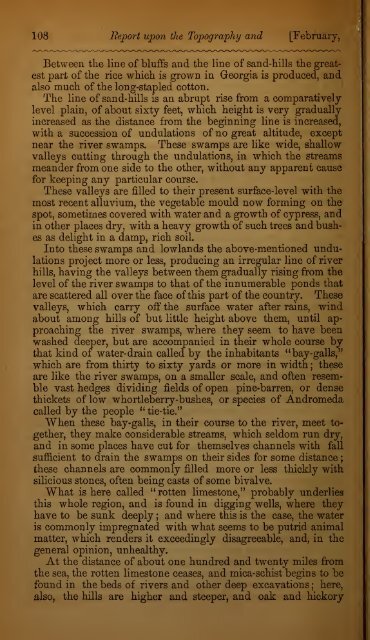1858.] Epidemic Diseases of the State of <strong>Georgia</strong>. 107M The growth of these isl<strong>and</strong>s is live-oak, water-oak, bay, gum,<strong>and</strong> pine. The live-oak predominates on the southern parts ofthe isl<strong>and</strong>s, almost to the exclusion of the pine ; while this lastis found at the northern end," The soil is a grayish <strong>and</strong> yellowish-brown s<strong>and</strong>, mixed withshells <strong>and</strong> vegetable mould, without any mixture or substratumof clay. This soil, for the most part, is thin, extending onlya few inches in depth." These isl<strong>and</strong>s are separated from the mainl<strong>and</strong> by extensivesalt-marshes, which are intersected by numerous creeks, <strong>and</strong>overflowed by every high tide." The isl<strong>and</strong>s are also separated from each other by sounds,or arms of the sea, which are the outlets of the rivers to theocean."Leaving the isl<strong>and</strong>s, <strong>and</strong> crossing over to the main, we enterupon another section or strip of country, varying in its topo*graphical features from the isl<strong>and</strong>s ; a low pine-barren, intersectedwith the rivers <strong>and</strong> swamps before mentioned."The growth of these barrens is the short-leaved pine, mimgled with scrub-oaks <strong>and</strong> gums. The soil is s<strong>and</strong>y, with here<strong>and</strong> there a sprinkling of red clay." In wet seasons, while the swamps are full of water, thisEine-barren soil is kept in a sobbed state, the drainage being bady reason of its flatness."Passing across this section, inl<strong>and</strong>, twenty or thirty milesin width, we strike a somewhat more elevated <strong>and</strong> rolling regionof s<strong>and</strong>-ridges <strong>and</strong> hills, intersected with bay-galls <strong>and</strong> branches,<strong>and</strong> sometimes ponds," The soil is s<strong>and</strong>y, with a substratum of clay at varyingdepths. The long-leaved pine takes the place of the short, <strong>and</strong>predominates, to the exclusion of almost every other tree."The mainl<strong>and</strong> adjoining the salt-marshes, which divide itfrom the Sea Isl<strong>and</strong>s between the Savannah <strong>and</strong> AltamahaRivers, usually commences with a line of bluffs, which risestwenty or thirty feet above the level of high water, separatedby arms of salt-marsh <strong>and</strong> small streams of fresh water, carryingthe water springing from a line of s<strong>and</strong>-hills twenty or thirtymiles further inl<strong>and</strong>.These streams have a tide flowing a distance of ten or fifteenmiles above the bluflfe, <strong>and</strong> for about the same distance furtherthey are margined by a fresh-water marsh <strong>and</strong> swamp, from halfa mile to a mile in width, with strips of higher l<strong>and</strong> betweenthem, which are of an older formation than the alluvium of theswamps, this last being yet in the process of deposit.Some of these strips of higher ground are remarkable for thegrowth of plants not usually found growing so near the seacoast.
;108 Report upon the Topography <strong>and</strong> [February,Between the line of bluffs <strong>and</strong> the line of s<strong>and</strong>-hills the greatestpart of the rice which is grown in <strong>Georgia</strong> is produced, <strong>and</strong>also much of the long-stapled cotton.The line of s<strong>and</strong>-hills is an abrupt rise from a comparativelylevel plain, of about sixty feet, which height is very graduallyincreased as the distance from the beginning line is increased,with a succession of undulations of no great altitude, exceptnear the river swamps. These swamps are like wide, shallowvalleys cutting through the undulations, in which the streamsme<strong>and</strong>er from one side to the other, without any apparent causefor keeping any particular course.These valleys are filled to their present surface-level with themost recent alluvium, the vegetable mould now forming on thespot, sometimes covered with water <strong>and</strong> a growth of cypress, <strong>and</strong>in other places dry, with a heavy growth of such trees <strong>and</strong> bushesas delight in a damp, rich soil.Into these swamps <strong>and</strong> lowl<strong>and</strong>s the above-mentioned undulationsproject more or less, producing an irregular line of riverhills, having the valleys between them gradually rising from thelevel of the river swamps to that of the innumerable ponds thatare scattered all over the face of this part of the country. Thesevalleys, which carry off the surface water after rains, windabout among hills of but little height above them, until approachingthe river swamps, where they seem to have beenwashed deeper, but are accompanied in their whole course bythat kind of water-drain called by the inhabitants " bay-galls,"which are from thirty to sixty yards or more in width ; theseare like the river swamps, on a smaller scale, <strong>and</strong> often resemblevast hedges dividing fields of open pine-barren, or densethickets of low whortleberry-bushes, or species of Andromedacalled by the people " tie-tie."When these bay-galls, in their course to the river, meet together,they make considerable streams, which seldom run dry,<strong>and</strong> in some places have cut for themselves channels with fallsufficient to drain the swamps on their sides for some distancethese channels are commonly filled more or less thickly withsilicious stones, often being casts of some bivalve.What is here called "rotten limestone," probably underliesthis whole region, <strong>and</strong> is found in digging wells, where theyhave to be sunk deeply ; <strong>and</strong> where this is the case, the wateris commonly impregnated with what seems to be putrid animalmatter, which renders it exceedingly disagreeable, <strong>and</strong>, in thegeneral opinion, unhealthy.At the distance of about one hundred <strong>and</strong> twenty miles fromthe sea, the rotten limestone ceases, <strong>and</strong> mica-schist begins to befound in the beds of rivers <strong>and</strong> other deep excavations ; here,also, the hills are higher <strong>and</strong> steeper, <strong>and</strong> oak <strong>and</strong> hickory
- Page 1 and 2: SOUTHERNMEDICAL AND SURGICAL JOURNA
- Page 3 and 4: ——76 Campbell's Lecture on Dyse
- Page 5 and 6: :75 CAMPBELL'S Lecture on Dysentery
- Page 7 and 8: •80 Campbell's Lecture on Dysente
- Page 9 and 10: .82 Campbell's Lecture on Dysentery
- Page 11 and 12: —84 Campbell's Lecture on Dysente
- Page 13 and 14: 86 Campbeli/s Lecture on Dysentery.
- Page 15 and 16: 88 CAMPBtfLl/s Lecture on Dysentery
- Page 17 and 18: 90 Campbell's Lecture on Dysentery.
- Page 19 and 20: 92 Eve's Notes on Diseases of the C
- Page 21 and 22: the94 Eve's Notes on Diseases of th
- Page 23 and 24: 96 Eve's Notes on Diseases of (lie
- Page 25 and 26: 98 Eve's Notes on Diseases of the C
- Page 27 and 28: 100 Eve's Notes on Diseases of the
- Page 29 and 30: :102 Eve's Notes on Diseases of the
- Page 31 and 32: 104 Eve's Notes on Diseases of the
- Page 33: :106 Report upon the Topography and
- Page 37 and 38: 110 Report upon the Topography and
- Page 39 and 40: 112 Report upon the Topography and
- Page 41 and 42: 114 On Rheumatism. [February,system
- Page 43 and 44: —116 On Rheumatism. [February,d 0
- Page 45 and 46: 118 On Rheumatism. [Februaryarus pr
- Page 47 and 48: 120 On Rheumatism, [February,Opium
- Page 49 and 50: 122 On Rheumatism. [February,head l
- Page 51 and 52: !;124 On Rheumatism. [February,not
- Page 53 and 54: —126 Exsection ofSecond Branch of
- Page 55 and 56: 128 Exsection ofSecond Branch ofFif
- Page 57 and 58: 130 Exsection ofSecond Branch ofFif
- Page 59 and 60: ;132 Exsection ofSecond Branch of F
- Page 61 and 62: ;134 Exsection ofSecond Branch ofFi
- Page 63 and 64: slightfiveswelling;136 ExsectionofS
- Page 65 and 66: —138 Editorial. [February,will sh
- Page 67 and 68: 140 Editorial. [February,the roof o
- Page 69 and 70: 142 Editorial. [February,the nutrit
- Page 71 and 72: 144 Editorial. [February,attach exc
- Page 73: —106 Editorial and Miscellaneous.








